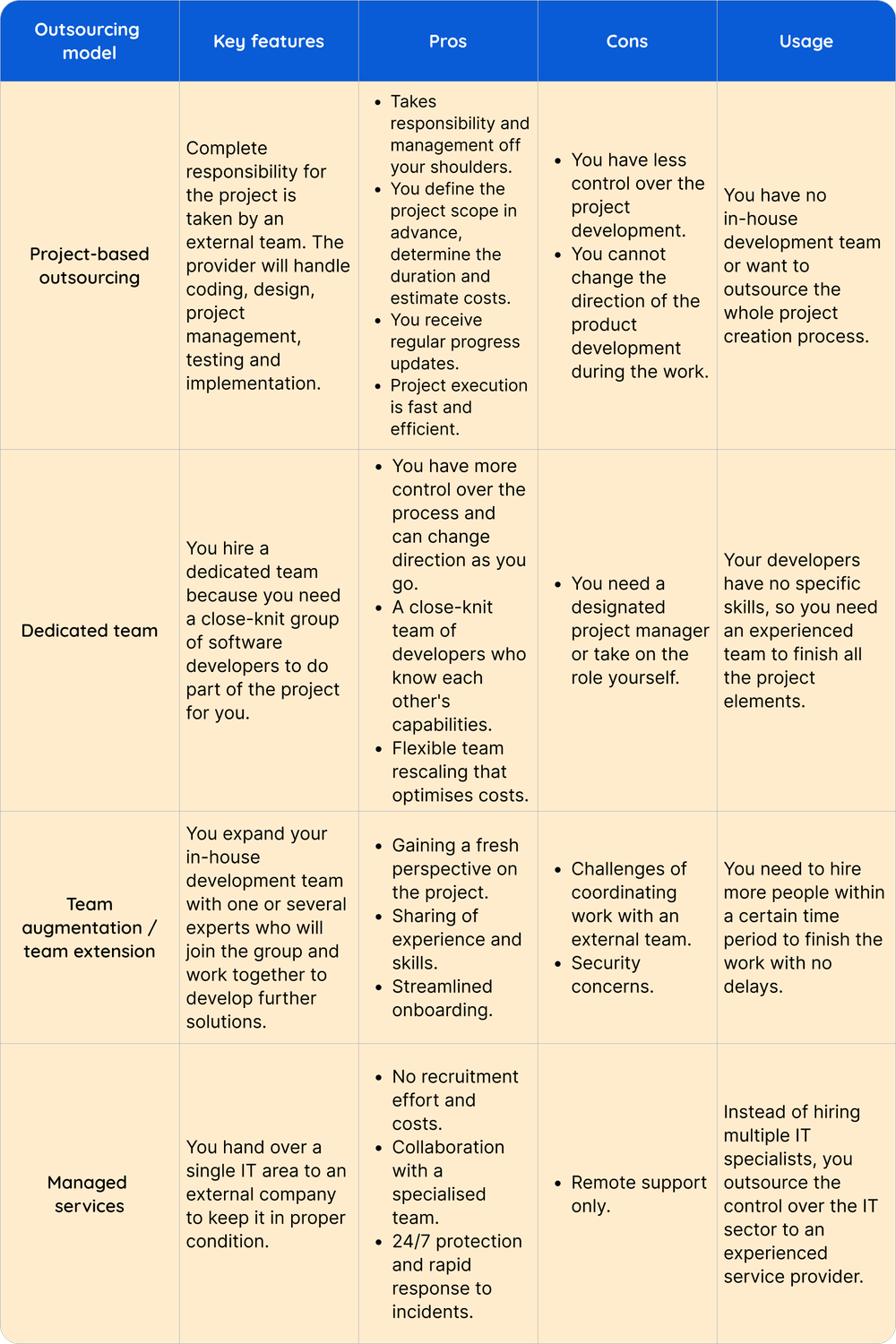Do you have a great idea for developing your business, but the software development department lacks the capacity or skills? In the age of widespread outsourcing of IT services, you no longer need to shelve your ideas or remove elements outside your company's technology stack. What exactly is software development outsourcing, and which strategy should you choose for your project? Check out our article for the answers to all your questions!
An overview of the outsourcing models for software development project
A classification of IT outsourcing:
- Project-based outsourcing
- Dedicated team
- Team augmentation / Team extension
- Managed services
IT outsourcing is a broad term that covers many different cooperation models. Each model relieves the burden on your company to varying degrees. Some are helpful when the in-house team has no more capacity, and others when you have no developers but want a stunning mobile app or other digital solution. That is why we have prepared an overview to explain the differences between the various outsourcing models and how they can benefit your project.
Project-based outsourcing
In this model, the complete responsibility for the project is taken by an external team. It means that the provider will not only handle the coding but also the design, project management, testing and implementation of the solution.
Pros of project-based outsourcing:
- Takes responsibility and management off your shoulders.
- You define the project scope in advance, determine the duration and estimate costs.
- You receive regular progress updates.
- Project execution is fast and efficient.
Cons of project-based outsourcing:
- You have less control over the project development.
- You cannot change the direction of the product development during the work.
Example: Jim runs an online sports shop and wants to introduce a mobile app. Therefore, he decided to outsource the project to an external company specialising in making mobile apps from scratch.

Dedicated team
A software outsourcing strategy in which you hire a dedicated team of developers is a good option when you need a close-knit team of software developers to do part of the project for you. In this model, the in-house project manager and the supervisor of the outsourcing team exchange regular updates on the progress of the next stages of the work. The dedicated development team is flexible and can be expanded or reduced depending on the project's needs.
Pros of a dedicated team:
- You have more control over the process and can change direction as you go.
- A close-knit team of developers who know each other's capabilities.
- Flexible team rescaling that optimises costs.
Cons of a dedicated team:
- You need a designated project manager or take on the role yourself.
Example: Kevin wants to build an ML-based chatbot-enhanced solution for accountants. To do this, he employs a dedicated team to create the chatbot, while the in-house team focuses on the product's core elements.
Team augmentation
Staff augmentation, team augmentation or body leasing involves hiring one or more software developers to take on tasks for which your in-house IT team no longer has the capacity. In the case of team augmentation, you do not hand over all or part of the responsibility for the project to an external outsourcing provider but coordinate it within your company. Staff augmentation employees are assigned to perform specific tasks.
Pros of team augmentation:
- Significant cost savings.
- The recruitment process is carried out by an outsourcing company.
- Flexibility and scalability.
- Full control over the whole project.
- Access to the global talent pool.
Cons of team augmentation:
- Possibility of language and cultural barriers.
- More responsibilities related to managing new employees.
Example: Stanley is developing a solution for a client but lacks the Java developers to complete the project on time. He decides to temporarily hire some skilled software developers to help him complete specific elements of the project.
Team extension
Although team extension and team augmentation may seem similar, hiring an extended team involves expanding your in-house development team with one (staff extension) or several experts who will join the group and work together to develop further solutions. As with team augmentation, the responsibility for the software product belongs entirely to your company.
Pros of team extension:
- Gaining a fresh perspective on the project.
- Sharing of experience and skills.
- Streamlined onboarding.
Cons of team extension:
- Challenges of coordinating work with an external team.
- Security concerns.
Example: Oscar is interested in hiring some seasoned programmers, but in his country, senior developers do not want to change jobs. Therefore, he opts for an extended team of remote professionals from Central Europe to turn his idea into a viable product.

Managed services
Managed services involve outsourcing a single IT area to an external company to ensure its proper operation. Under managed services, you can hire specialists in network monitoring, cyber security, backup, cloud services or other areas. In 2023, the managed services market was worth USD 278.9 billion and is sure to grow in the next few years.
Pros of managed services:
- No recruitment effort and costs.
- Collaboration with a specialised team.
- 24/7 protection and rapid response to incidents.
Cons of managed services:
- Remote support only.
Example: Michael's company faces frequent hacking attacks, so he employs a managed IT service company that continuously monitors the corporate network and responds to any attempted security breaches to the systems.

Conclusion
There is no golden strategy to properly outsource the software development process. Nevertheless, thanks to the wide variety, you can choose a cooperation model that both ensures the highest quality and reduces unnecessary expenses. Therefore, question, test and sign contracts with outsourcing software development services that have business experience and excellent technical skills.
Do you want to know more about our Team Augmentation process? Watch this video to explore details.

Kuba Waliński
Jack of all trades, master of none. Sometimes a team geek, sometimes a lone wolf, or even a dark matter developer. Able to keep his nose above water at all times.

How fractional CTOs transform eMobility teams – from firefighting to foresight
When experience and speed matter, a CTO as a Service might be your best choice.

Aleksandra Stokłosa
Partnership manager

From doubt to confidence – Strategies to beat impostor syndrome
Beat impostor syndrome and rebuild your confidence – discover strategies that truly work.

Martyna Kąciak
Head of HR

What’s troubling the EV industry in the UK? 3 observations from the eMobility summit
EVs promise progress, yet challenges persist. Discover what’s slowing the UK’s eMobility revolution.

Aleksandra Stokłosa
Partnership manager
Looking for the IT partner recognised for excellence?
We’ve earned industry-leading awards for delivering top-notch solutions across multiple sectors.











